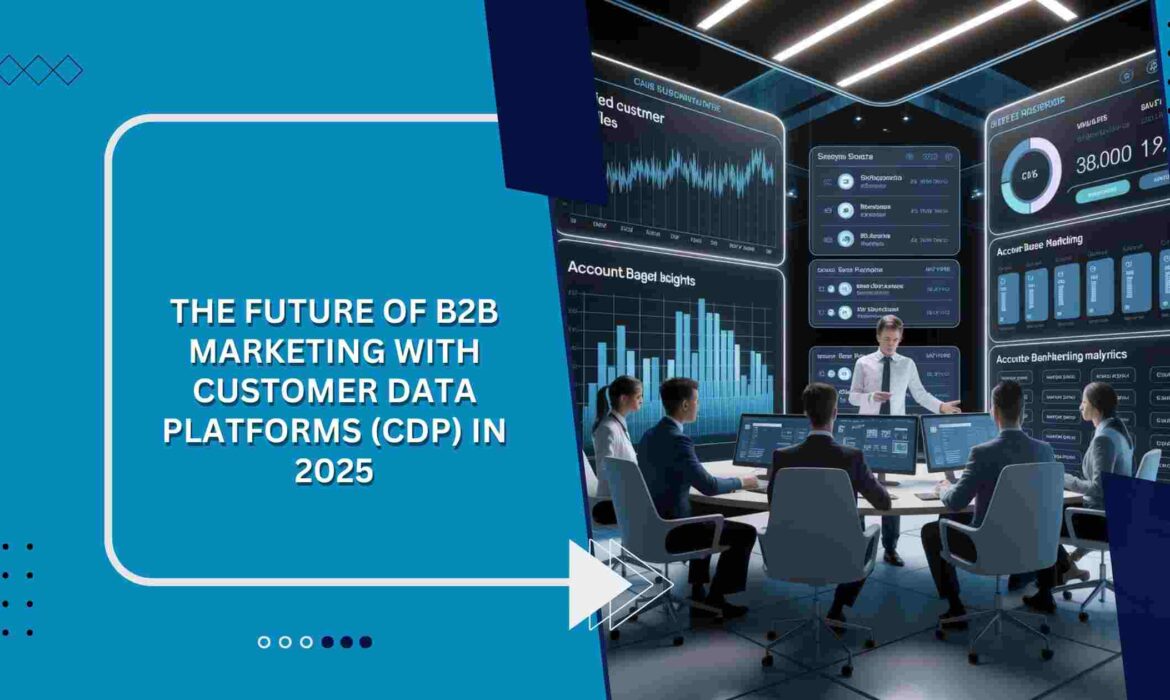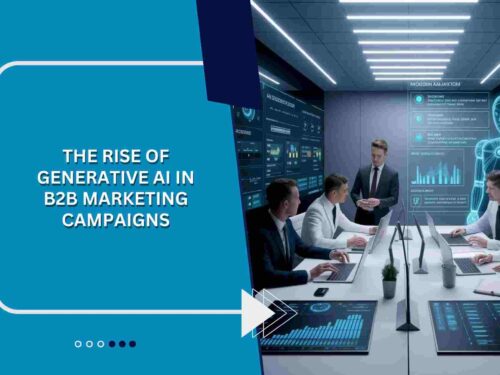In 2025, the competitive landscape of B2B marketing is being reshaped by technology that prioritizes data, personalization, and customer intelligence. Among the most powerful tools driving this transformation is the customer data platform (CDP). For B2B organizations, the adoption of a customer data platform has shifted from being an experimental solution to a core Fdriver of growth, revenue alignment, and buyer engagement.
This blog explores why a customer data platform is more than just another martech tool it’s the foundation of B2B marketing in 2025.
What Is a Customer Data Platform in B2B?
At its core, a customer data platform is a centralized system that collects, unifies, and organizes customer and prospect data across multiple touchpoints. Unlike a CRM or a simple data warehouse, a CDP is designed specifically to:
- Gather structured and unstructured data from multiple channels.
- Clean, standardize, and deduplicate information.
- Create a single source of truth about accounts and individuals.
- Make data actionable for sales, marketing, and customer success teams.
In the B2B ecosystem, where buying decisions involve multiple stakeholders and longer sales cycles, a customer data platform doesn’t just unify contact records. It maps individuals to their accounts, tracks buying committees, and records every touchpoint across digital and offline channels.
Why B2B Businesses Need a Customer Data Platform in 2025
The modern B2B buyer journey is fragmented, digital-first, and far less predictable than it was a decade ago. Here’s why a customer data platform is becoming essential this year:
1. Breaking Down Data Silos
Data is scattered across CRMs, marketing automation platforms, email systems, event tools, and customer success software. Without unification, marketing teams miss insights, and sales teams struggle to act on real buyer signals. A customer data platform breaks down silos and ensures every department works with the same trusted dataset.
2. Identity Resolution Across Buying Committees
B2B deals often involve multiple decision-makers IT managers, finance leaders, operations heads, and executives. A customer data platform uses advanced identity resolution to connect multiple contacts to one account, ensuring marketers understand the full buying committee and not just one lead.
3. Precision for Account-Based Marketing (ABM)
In 2025, ABM remains a top strategy for high-value B2B growth. With a customer data platform, marketers can build account-level profiles, segment based on firmographics, and trigger campaigns tailored to the exact stage of the buyer journey.
4. Real-Time Buyer Insights
Timeliness is everything. When a decision-maker visits a pricing page or downloads a whitepaper, a customer data platform captures the signal instantly and enables outreach at the right moment. This real-time engagement often defines whether you win or lose the deal.
5. Revenue Attribution and ROI Clarity
B2B leaders are under constant pressure to justify marketing spend. A customer data platform tracks every touchpoint ads, webinars, email clicks, website visits and ties them to opportunities and revenue. This clarity helps optimize budgets and align teams toward revenue outcomes.
Key Features of a Modern B2B Customer Data Platform
Not all CDPs are created equal. The most effective B2B customer data platforms in 2025 offer the following capabilities:
- Unified Profiles: Create 360-degree views of customers and accounts by consolidating data from multiple tools.
- Real-Time Data Processing: Capture and activate data instantly, enabling sales to act on live buyer signals.
- Segmentation & Personalization: Build dynamic segments using behavior, firmographics, and intent data for hyper-personalized campaigns.
- Data Cleansing & Deduplication: Automatically correct errors, remove duplicates, and ensure accuracy in records.
- Cross-Channel Activation: Push clean customer data into CRMs, ad platforms, and marketing automation systems.
- Governance & Compliance: Maintain strict adherence to data privacy laws while leveraging data responsibly.
Customer Data Platform vs CRM vs DMP
Many B2B leaders confuse CDPs with CRMs or DMPs (data management platforms). The distinction is critical:
- CRM: Primarily stores sales and contact records but lacks advanced identity resolution or real-time data activation.
- DMP: Focuses on third-party anonymous data, mostly for ad targeting, but doesn’t store persistent customer records.
- Customer Data Platform: Builds long-term, persistent profiles with both first-party data and third-party data, making it actionable across marketing and sales workflows.
In short, the customer data platform is the bridge that connects marketing ambition with actionable sales execution.
The Evolution of Customer Data Platforms in 2025
CDPs have been around for a few years, but in 2025, their role has expanded significantly:
AI-Powered Predictions
Modern CDPs use artificial intelligence to analyze behavioral patterns, predict buying intent, and highlight accounts most likely to convert.
Composable Architecture
Instead of relying on monolithic solutions, businesses now prefer composable CDPs that integrate directly with their existing data warehouses and tools, offering flexibility and scalability.
Real-Time Orchestration
CDPs are no longer just passive storage systems. In 2025, they orchestrate real-time engagement like alerting sales when a high-value account shows intent signals.
Deeper Compliance Features
As data privacy regulations expand, CDPs are embedding compliance frameworks for GDPR, CCPA, and global data rules. This ensures trust while maximizing data utility.
How B2B Marketers Put Customer Data Platforms to Work
The practical applications of a customer data platform are vast, and their impact is visible across every stage of the customer lifecycle. For demand generation, CDPs provide the intelligence needed to run highly personalized campaigns, delivering content that aligns with the role, industry, and stage of each stakeholder in the buying process. Instead of one-size-fits-all emails, marketers can send tailored messages that resonate with CFOs differently than with IT managers, increasing relevance and response rates.
In sales, CDPs help teams prioritize accounts by analyzing engagement patterns and intent signals. When multiple contacts from a target company are interacting with high-value assets such as case studies or pricing calculators, the CDP highlights the opportunity and pushes it to the top of the sales team’s list. This ensures that sales resources are directed where they matter most.
For customer retention, a customer data platform tracks product usage and engagement levels, flagging accounts that show signs of disengagement. This proactive insight allows customer success teams to intervene early, preventing churn and uncovering upsell opportunities. By uniting data from marketing, sales, and service, CDPs ensure that the entire customer journey is continuously optimized.
Challenges in Implementing a Customer Data Platform
While the benefits are clear, B2B companies should be aware of common challenges:
- Integration Complexity – Connecting multiple systems requires strong IT and RevOps collaboration.
- Data Quality Issues – A CDP is only as good as the data fed into it; poor data quality reduces effectiveness.
- Change Management – Teams must adapt to new workflows and learn to rely on unified data instead of siloed systems.
- High Expectations – Companies often expect instant ROI, but CDPs require ongoing optimization.
Overcoming these challenges requires a mix of strategic planning, executive buy-in, and strong alignment between marketing, sales, and IT.
Real-World Scenarios in 2025
Consider a B2B SaaS provider targeting enterprise clients. Its marketing team notices through the CDP that several IT directors and procurement managers from a Fortune 500 company are engaging with technical documentation. At the same time, the platform identifies an executive from the same account who recently attended a webinar. The sales team receives an alert and tailors outreach specifically to this buying committee. Because the engagement is timely and relevant, the deal progresses faster than expected.
In another case, a cybersecurity firm uses its customer data platform to track usage patterns among existing clients. The system detects that several accounts are approaching thresholds that typically precede upgrades. Instead of waiting for renewal discussions, the customer success team proactively reaches out with tailored upsell offers, increasing expansion revenue.
These scenarios illustrate how CDPs move beyond theory to deliver measurable impact in real-world B2B environments.
If your organization wants to unlock the full potential of a customer data platform and explore how emerging technologies are shaping modern B2B growth strategies, we recommend diving deeper into the latest insights at Acceligize.




